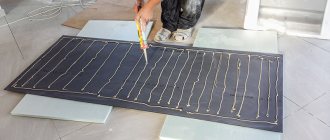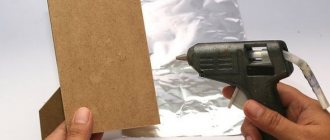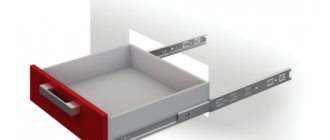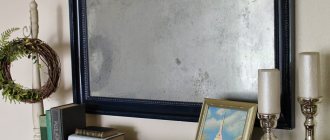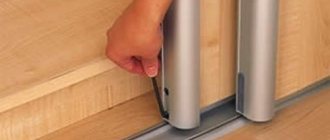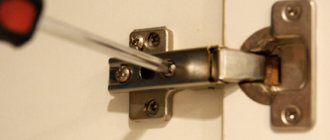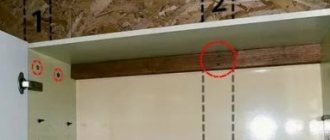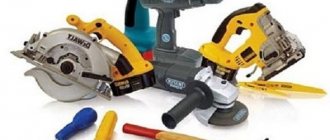Sometimes you want to buy a mirror of some intricate shape, but it is quite difficult to find non-standard items in stores. Of course, you can use the help of a specialist, but if you came to this page, it means that you assume that you can do without it. The most important thing in this matter is to handle the product with extreme caution and strictly follow all rules and recommendations. If you're capable of it, cutting won't seem like a chore. Why not try it? It's always interesting to learn something new.
Sometimes you want to buy a mirror of some intricate shape, but it is quite difficult to find non-standard items in stores.
Safety precautions when cutting glass
Before cutting a mirror with a glass cutter, read the safety requirements.
- Put your workplace in order, remove everything unnecessary from the table. Place the scrap boxes, work tools and the product itself in their places.
- Make sure all accessories are in working order.
- Place rubber tips on the jaws of the pliers or wrap them in something.
- Boxes with glass are always installed vertically.
- Be sure to use a special suit, gloves and safety glasses.
- Take your time and try not to make sudden movements.
- Do not touch the cut line of the glass with fingers not protected by gloves.
- It is prohibited to cut the product on objects not intended for this purpose.
- When working at height, glass must not be thrown down. Always take scraps and whole glass with you.
- It is permissible to cut only in the direction opposite to the direction of the cutting part.
- The glass must be installed on strong supports with an inclination of up to 15°.
- As you work, place unnecessary trimmings in a box and throw them in the trash as they accumulate.
- Remove glass from boxes carefully. If the glass is cracked, remove it in separate pieces.
- Do not cut the product on your knees.
- Use electric glass cutters carefully.
- If the product is brought in from the cold, be sure to warm it up.
- Sweep the floor and clean the workbenches with a special brush. Do not try to blow away glass dust.
- Before finishing work, shake the special suit thoroughly to remove any crushed glass particles.
First, the entire surface of the mirror must be thoroughly cleaned and rinsed with soda solution.
The place where cutting will take place must be level so that the mirror fits tightly over the entire surface.
Device design
Diamond glass cutter is based on the following parts:
- Pen. It is made taking into account the ease of use of the tool, so it has a teardrop shape. It is made from various materials: wood, polystyrene or phenolic.
- Kernel. Performs the function of a frame. It looks like a brass or steel tube, which is coated with a protective anti-corrosion coating on top.
- Hammer. Made from durable grades of brass or steel. It has the shape of a truncated diamond and is located at the very edge of the instrument. The hammer has special slots that simplify the process of breaking off glass or mirror along the cut line.
One diamond glass cutting stone should be enough for 11.5 km of sheet glass, the diameter of which is 5 ml.
Required Tools
Be sure to check that all materials are present before cutting the mirror. The most standard table will do, the main thing is that the dimensions of the tabletop correspond to the area of the mirror surface, and ideally exceed it.
There are two types of glass cutters: diamond and roller, and a mirror at home can be cut with both.
If you plan to insert a mirror into a frame, get one in advance.
Then you need to attach a ruler, preferably a metal one, to the line.
The work should be done carefully, without rushing.
The most important tool is, of course, a glass cutter. There are three types of tools that can be used to cut glass at home:
- roller - the cutting part is made of a particularly durable alloy;
- diamond – technical diamond is used as the cutting part;
- oil - have the same characteristics as roller ones, there is an additional reservoir.
This technique allows you to control the correct position of the cutting part of the glass cutter and guarantees that the glass cutter will not jump off this line onto the ruler.
If you are wondering which glass cutter you should buy, choose a diamond one. It is superior to roller in both quality and service life.
It is clear that the cutting element must be located strictly on the marked line and perpendicular to the surface of the mirror.
During operation, the glass cutter is pressed tightly against the surface of the mirror and the ruler.
Another necessary tool is a special thick ruler or square for cutting glass. However, you can use a regular metal ruler, you just need to improve it slightly. To do this you will need several rubber or leather pieces. You need to put a ruler on them. This will prevent the metal from sliding on the glass and will raise the ruler to a level high enough for the glass cutter to rest on.
The pressure and movement of the glass cutter should be smooth and progressive.
You will also need pliers and a hammer, which is designed to facilitate the process of breaking glass by tapping the mirror from the back side. It is advisable that the hammer be small.
When cut correctly, a thin white line will be left on the surface of the mirror.
The specialist is able to determine by ear whether the cutting has been carried out correctly - by the characteristic light cracking sound.
It is highly advisable to cover the tabletop with a blanket. The fabric must be natural and have the necessary density, because you will be using it to manipulate the mirror. If you do not use a blanket, the fragile glass on a hard table surface can crack with any careless movement.
When the cut line is ready, the mirror lies on the edge of the surface (table, workbench, stool).
The last element is a water-soluble felt-tip pen or wax pencil for marking.
If this does not work, then you need to tap the entire line from below with a small hammer, moving the hammer from its far end towards you.
Types of glass cutters
There are two types of glass cutters - diamond, which is made from a piece of industrial diamond, and roller, which has a wheel made of cobalt-tungsten alloy or steel. Glass cutters are also oil-based , and make working with the surface easier. Roller glass cutters come with one or several wheels - in order to change them when one of them becomes dull.
I didn’t find any particular differences when working with a roller glass cutter and a diamond glass cutter; for some it’s easier to cut with a roller cutter, while for others the diamond one slides to the side. Therefore, it is important to buy a quality tool and practice.
How to prepare glass for the procedure?
To prevent the cut line from going sideways in the future, the surface of the product must first be cleaned and washed with soda. If stains and dirt are difficult to wipe off, use alcohol. Special glass liquids will help you wash an old mirror. There is no need to wipe it with a cloth after cleaning, as it will certainly leave unnecessary lint.
After this, if the piece does not separate, the cutting process should be repeated.
If you have just purchased a mirror, you need to leave it for a couple of hours in the room where the entire cutting process will take place. During this time, the product adapts to the temperature and humidity of the room. Then, if the mirror was previously in a box, wipe it with paper napkins.
If possible, it is better to purchase a diamond glass cutter - it cuts better and has a longer service life.
Make sure that the area where you will be cutting is perfectly level, otherwise the product will not be able to lie tightly on the surface. Think about the soft blanket that you need to cover the surface of the table. Place the product on your work surface with the reflective side facing up.
When cutting glass, it is better to wear safety glasses.
The main thing is to do the work calmly and carefully, and then you will succeed.
The next stage is marking the cutting line. Remember the proverb “measure twice, cut once”? It suits our situation perfectly. After measurements, carefully draw a cutting line with a wax pencil. Then apply a metal ruler to it. Don't forget to place pieces of rubber or leather underneath it.
In some cases, rubber-lined pliers are used to remove cut pieces of a thin mirror.
Now all you have to do is insert the mirror into a pre-prepared frame.
Preparatory work
To properly cut glass at home, you need to have the appropriate tools and a place to process it.
Necessary tool
To work, a home craftsman will need a minimum set of:
- glass cutter, maybe an old-fashioned design or a more modern one with a container for lubricating the roller with kerosene;
- marker for marking glass blanks;
- construction square, providing control of right angles;
- ruler for marking and orienting the cutting line.
At the stage of marking the workpiece for cutting grooves, it is necessary to maintain dimensional accuracy: the width of the working head of the glass cutter should be taken into account. It is 5 mm, and the axis of the cutting roller deviates from its side edge by half this value.
When choosing a ruler, pay attention to its thickness. Thin and pointed side edges are not suitable
The glass cutter head will not move well along them.
When placing the ruler on the glass, from its edge to the axis of the roller, it is necessary to create an indent of 2.5 mm.
For such work, it is convenient to use a piece of laminate or a flat strip. To prevent such a template from slipping off the surface of the glass when cutting, cloth or fabric tape is glued to its bottom side.
Workplace
Glass does not withstand local lateral loads well. The pressure from the glass cutter is what causes them. Therefore, a home craftsman should work with glass only on a prepared, clean and level surface.
A coating made from a solid sheet of fiberboard and similar materials is well suited. It is perfectly acceptable to cover a regular table with a blanket and cut on it.
Let's start cutting
The glass cutter should be positioned at right angles to the mirror surface strictly on the marked line. Pressing it slightly against the glass, it must be carefully guided in the direction leading to you. Do not hurry. Move the glass cutter gently and precisely along the marked line. If you hear the sound of glass being cut, then everything is going well. A squeak indicates that the glass cutter is broken or you are doing something wrong.
Special glass liquids will help you wash an old mirror.
When cut correctly, you will see a thin line on the glass. If all goes well, place the mirror on the workbench so that the line extends slightly beyond the edge. Then press lightly on the cut part, holding the other one with your other hand. The glass should fall off. If this does not happen, tap the entire line from the bottom side with a hammer, moving it towards you. Does not work? Repeat the cutting procedure again. Small fragments are removed using pliers.
If you have just purchased a mirror, you need to leave it for a couple of hours in the room where the entire cutting process will take place.
Attention! If you do not have special glasses, do not bend too low when working to avoid getting shrapnel in your eyes.
A squeak indicates that the glass cutter is broken or you are doing something wrong.
How to cut a mirror at home: choosing the best way
Hi all! Mirrors are an integral part of any interior. That's why you have to deal with him very often. You can order a finished product with a bevel or an original frame, or do it yourself, using a mirror cloth as a base. In this case, the question remains open about how to cut a mirror and what is required for this at home.
Mirrors come in a wide variety. Moreover, you can create something unusual, original from a simple canvas yourself, or simply save on buying ready-made decorated mirrors.
Why exactly such a procedure may be required is not fundamentally important. It is much more important to understand the methods of cutting yourself and their features. This will give you the opportunity to cut a mirror for wardrobes or for the bathroom. Here you decide for yourself when and why you will need it.
The most effective method
It is more correct and efficient to cut with a conventional glass cutter. It can be indispensable if you decide to make a dressing table yourself, or to restore old mirrors to decorate the interior of your own home.
The advantages of special tools are that with their help you can easily cut out even quite complex elements, process a thick mirror and set the desired shape of the canvas.
When purchasing a glass cutter, be sure to pay attention to its type. The tool can be roller or diamond. The first one is more budget-friendly, but has lower accuracy, quality and cutting speed. Diamond glass cutters are expensive, but with frequent use, the investment will be fully worth it.
It won’t take much time to learn how to properly operate such a device. By following certain rules, you will be able to achieve the desired result:
- The glass cutter must be held at a right angle, but a slight deviation is allowed;
- pressing with the index finger, the instrument is firmly fixed with the middle and thumb;
- while moving along the blade, you cannot change the position of the cutter;
- it is extremely important to make the cut with a quick and confident movement;
- It is not recommended to make a second cut along the same line;
- a strictly uniform force is applied, but except at the edges;
- when approaching the edge approximately 5 mm before the edge, you need to reduce the load on the glass cutter;
- the cut is made from the far point towards you;
- a high-quality cut is obtained in a dark color in the case of a roller tool;
- Diamond cutters always leave behind a light, thin strip;
- It is not recommended to deepen poorly executed cuts, but it is better to step back a little and make a new one.
As you can see, there are quite a lot of nuances. But they can cause some difficulties only during the first attempts to cut the mirror cloth yourself. With a little practice, everything will start to work out quickly and efficiently.
Sequence of procedure
Some cut an old, previously glued mirror, while others use new canvases. But regardless of this, cutting requires mandatory preliminary preparation, as well as correct execution of the procedure. Only then will you choose the method of attaching the mirrors, or select the appropriate glue for the mirror to fix it.
If we consider the process step by step, it involves the following steps:
- First you need to prepare a flat surface of appropriate size. Often this is done simply on the floor, but it is better on the table. The canvas is laid face up;
- Be sure to place a soft lining under the mirror so as not to damage it when pressed;
- The surface is cleaned with a soda solution and then with alcohol;
- All irregularities on the reverse side should also be removed and leveled;
- At the next stage, markings are applied. The line should run 2 mm further than the future cut, since finishing is still to be done;
- Using a ruler to control the straight cutting stroke, a glass cutter is used;
- After making the cut, the mirror is moved to the edge of the table and hangs out a little. The cut part is carefully separated;
- You can remove excess after a cut with gloved hands, a rubber hammer, or pliers with plastic (rubber) pads;
- Using fine-grained sandpaper, process the sections.
That's it, now you have managed to cut out the required element. What to do with it next depends on specific goals and objectives.
As you can see, using a glass cutter is not so easy, but it is the most effective and useful tool in such matters.
Alternative options
Agree that not everyone has glass cutters. Therefore, many go in search of alternative options so as not to spend extra money on the purchase of special tools.
On the Internet you can find many videos in which glass and mirrors are cut with all kinds of improvised means.
I want to tell you about several original and simply effective ways to replace a glass cutter and cope with the task.
- Tile cutter. If available, you can process a fairly thick mirror sheet with a tile cutter. But again, the tool is not cheap. If you choose, it is better to buy a diamond-type glass cutter;
- With scissors and in water. A method that many people don’t believe in until they try it. This method will not cut tempered glass. And ordinary ones are easily cut, like cardboard. To do this, you need to immerse the product in hot water, having previously applied markings, and cut off the excess under water with sharp scissors;
- Water, rope and flame. The idea is to soak a string made of natural material in gasoline, kerosene or alcohol, lay this string along the marking line, and then set it on fire. When the fire goes out, cold water is poured through the line in a thin stream. This causes the glass to crack. Then all that remains is to refine the edges with sandpaper;
- File with soldering iron. First, a notch is made on the edge of the mirror, thereby creating a mark for the start of the cut. Next, follow the markings with a hot soldering iron. This allows you to create a crack along a given trajectory;
- Nail, grinder, burner. Again, a cut is made with a grinder. Although here you can use a regular nail, which scratches out the edge. Instead of a soldering iron, but according to a similar scheme, a burner is used. Even just a hot nail can cut mirrors and glass if desired.
The options are truly varied. Moreover, all of them are tested in practice and have proven efficiency and performance.
But let's be objective. To get a high-quality result, it is better to use an appropriate device at home, designed specifically for such tasks. So far, nothing has been invented that is more effective than a diamond glass cutter.
If you have doubts about your own abilities, or do not want to spend a lot of money on a one-time project to cut mirrors yourself, contact a specialist. They will make the necessary cuts themselves and cut the mirror strictly according to the given shape.
It is done!
The work is almost finished. Now all you have to do is insert the mirror into a pre-prepared frame. If there is none, cover the sharp edges with sandpaper to protect yourself from cuts.
When cut correctly, you will see a thin line on the glass.
As you can see, the glass cutting procedure is not that complicated. The main thing is to do the work calmly and carefully, and then you will succeed!
. If all goes well, place the mirror on the workbench so that the line extends slightly beyond the edge.
Tips for the final stage
- First, practice on unwanted pieces of mirror.
- If the cut lines are straight, for example for a square mirror, place it on a flat surface so that the cut extends just a little beyond the edge of the table. Press down on the canvas, hold it with one hand, and press down on the free edge with the other hand. This will give you a clean break.
- If the figure requires minor cutting, use a cutter with a steel ring.
- If you need to separate the canvas along the wavy cuts, turn the mirror over, place it on foam plastic, cardboard or any other springy surface, press on the lines with your index finger, then the cut should split.
Once the mirror is detached, you can either frame it or sand the edge with fine-grain paper. This way you will avoid accidental cuts.
Don’t be afraid to cut a mirror at home, the main thing is to do everything carefully and thoughtfully!
Preparation of the mirror surface
It is important to understand that before you start manipulating a mirror or glass, it must be wiped in order to remove all dirt and dust from the surface. But it’s better to do this with baking soda, as it helps with better cleansing.
If soda is powerless against any stains, then you can use alcohol.
Use modern techniques to cut mirrors.
It is also possible to use a special glass liquid
No matter what cleaning liquid was used, you should then wipe the surface dry on both sides with a cloth that has a good level of hygroscopicity. Only this will allow you to collect all the remaining moisture.
Carefully begin cutting out the mirror.
Nuances and recommendations of the masters
- The functionality of the tongs and the glass cutter-roller is combined with the tile cutter-tongs. It is suitable for processing the most difficult types of tiles.
- An oil tile cutter requires filling the container no more than a third full. To cut a limited number of ceramic products, simply dip the roller into a container of lubricant.
- Tiles intended for sawing must be free of dust and dirt. This will help maintain the trajectory of the glass cutter.
- If it was not possible to cut through the tile the first time, you need to return 2-3 mm from the place of separation and continue to draw the line.
- At the beginning and end of the outlined cutting line, use the glass cutter with less pressure to avoid splitting.
- Beginners should use lightweight glass cutters with wooden handles.
Using a glass cutter to cut tiles is justified at home. The method is considered acceptable only for thin wall tiles. To work with more durable materials, it would be advisable to use a power tool.
